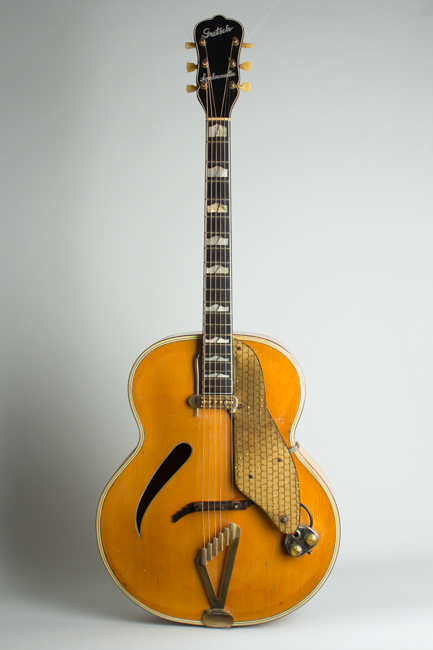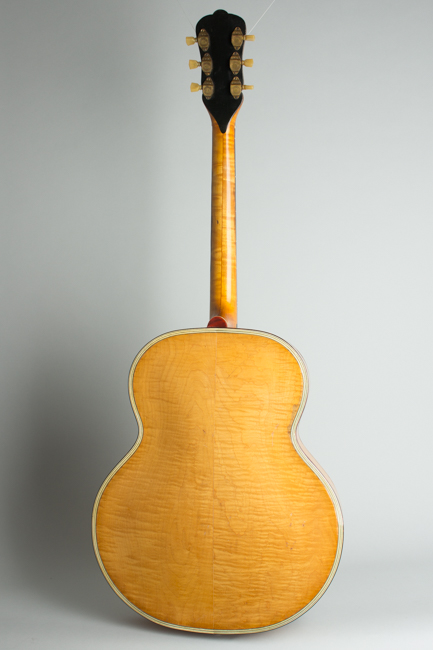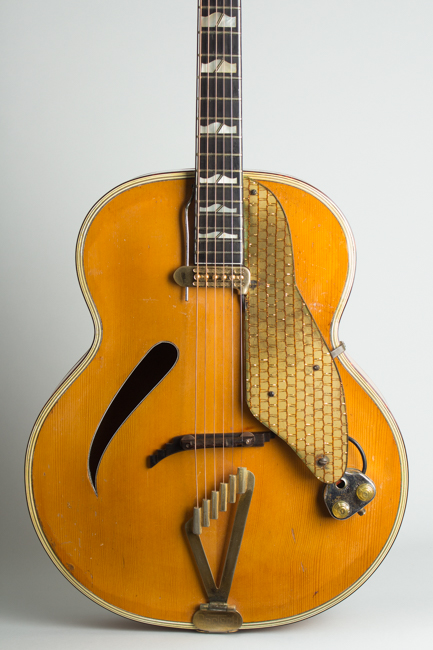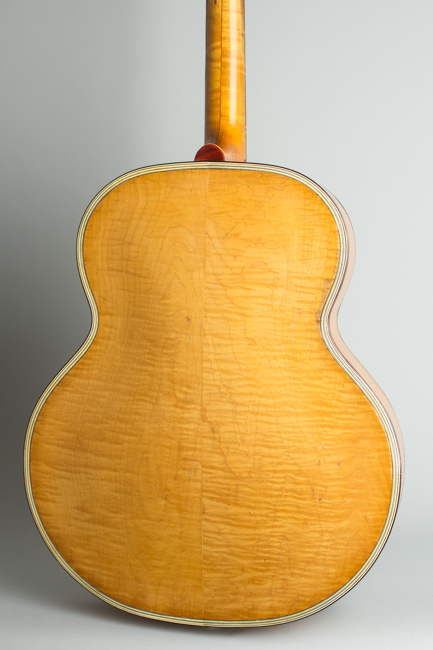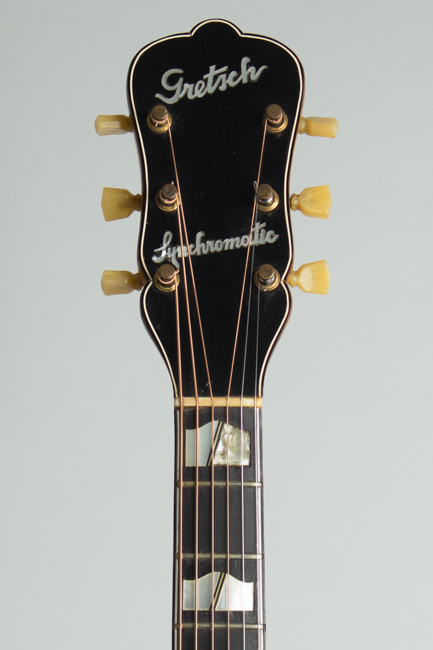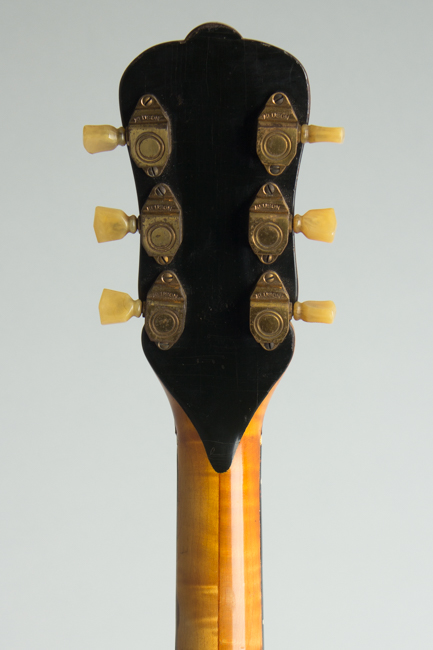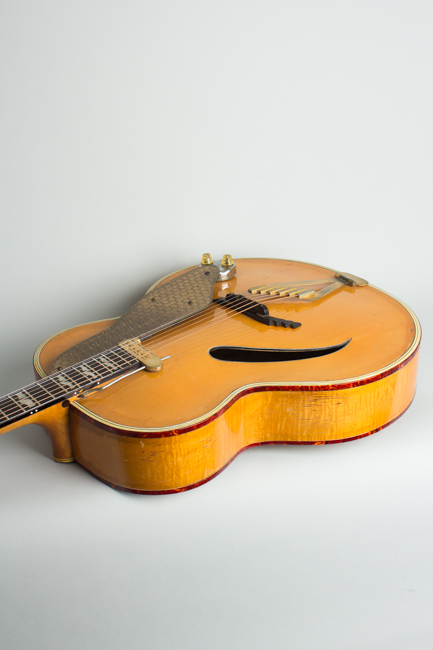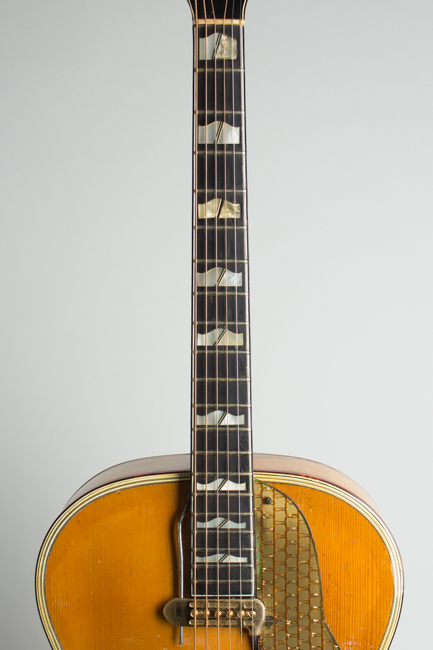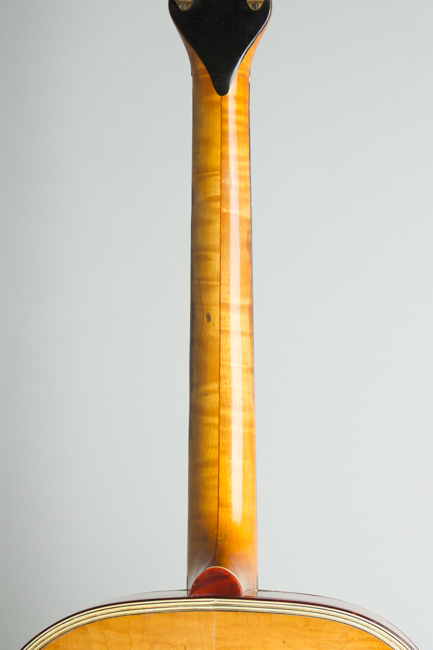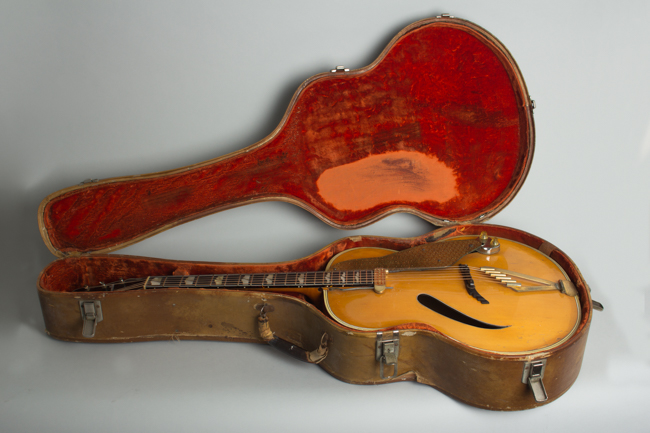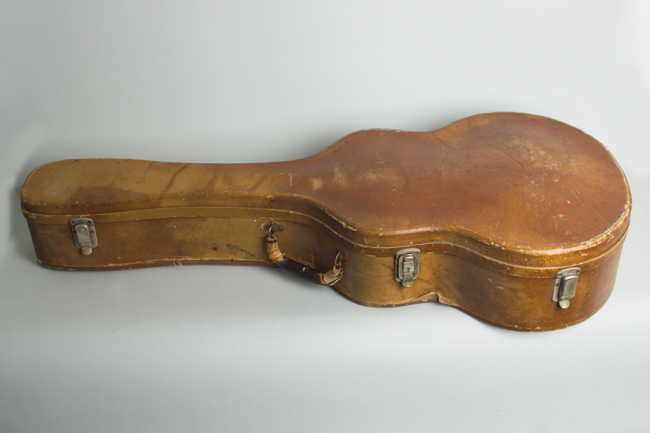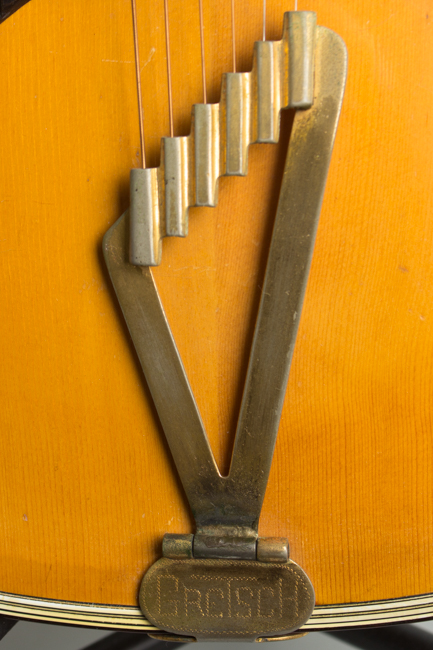Gretsch Synchromatic 300 Arch Top Acoustic Guitar (1940)
This item has been sold.
Item # 9558
Prices subject to change without notice.
Gretsch Synchromatic 300 Model Arch Top Acoustic Guitar (1940), Brooklyn, NY.
In the late 1930's Gretsch was an up-and-coming musical instrument company, and the professional guitar market was ruled by big, flashy acoustic archtops. The Brooklyn firm had built some decent guitars earlier in the decade but around 1939 threw their hat fully into the ring with some of the biggest and flashiest ever made. These were dubbed the "Synchromatic" line, and while the instruments never seriously rivaled Gibson or Epiphone in sales they remain singular creations, unlike anything before or since.
The Synchromatics were idiosyncratic in every way, built around features Gretsch termed "7 points of supremacy" and both visually and structurally a departure from anything previously offered anywhere. The "7 Points" touted the "non-pressure neck", "Streamlined tone holes", "Chromatic tailpiece" and "Synchronized bridge "as the most distinctive advantages, alongside more prosaic features like the finish and 3-year guarantee. The line was introduced in 1939 but the advent of WWII meant that Gretsch was a bit late to the archtop party, and production on the 4-model professional Synchromatic line (models 400, 300, 200 and 160) was extremely limited.
This gleaming blonde Synchromatic 300 is a visually stunning guitar, but no slouch in the sound department either. At 17 3/8" wide the body is larger than the competing Gibson L-5 and the same as the contemporary Epiphone Deluxe, the two models it directly competed with at a $300 list price. At 26" the scale length is longer than either, adding extra depth to the sound. The "Miracle neck" is quite slim with a slightly asymmetrical round-backed contour, built up with multiple layers of wood laminates under the fingerboard that Gretsch called "pregwood". The straight-grained top is carved fairly thin and has delicately sculpted parallel bracing resulting in a very lively sound.
This guitar has multiple binding everywhere, including the "Light bulb" headstock and ebony fingerboard, which has shaped split block inlay. The gold-plated tuners are the then-new Kluson Sealfast units Gibson used at the same time. The original bridge and tailpiece are stylish deco sculptures in their own right. This guitar plays very well and sounds fabulous, either acoustically or with the gold DeArmond Model 1100 pickup fitted to the over-the-top wild replaced pickguard. Simply a superb Brooklyn rarity and one of the most individual and unique of all pre-war archtops.
Overall length is 43 3/8 in. (110.2 cm.), 17 3/16 in. (43.7 cm.) wide at lower bout, and 3 1/2 in. (8.9 cm.) in depth, measured at side of rim. Scale length is 26 in. (660 mm.). Width of nut is 1 5/8 in. (41 mm.).
This guitar has had a long, active life and seen both wear and repair along the way, but remains a fine playing and sounding instrument. The finish has general wear overall with scratches, dings and scuffs and some spots worn through but no large areas of heavy wear. The outer layer of tortoise celluloid binding on the body was replaced probably decades ago; the edges were oversprayed at the time and now that clearcoat has darkened a bit and is visible but not too distracting. All other binding appears original and intact, except perhaps the F-hole edges which show some evidence of repair.
All of the hardware is original except the pickguard, which is a very old replacement made out of fantastic gold patterned radio-shop Lucite, custom fitted in the same shape as the original. We think this of one of the coolest things we have ever seen, but a repro of the original tortoise celluloid pickguard could be fabricated if desired. The 1960's DeArmond Model 1100 is rigged to this pickguard, including the control box which is somewhat worn. The tone and volume controls are intact and functional but the "Rhythm" switch has been removed.
This guitar has been refretted and there is minimal wear to the wire. The neck angle is good, the neck itself has some very slight relief and playability is excellent. This guitar apparently spent its life in and around Hoboken NJ where it was the gigging instrument of one player for decades, and it really has that played-in vibe in spades. The replaced pickguard was specially crafted for him decades ago (Based on the material probably in a local electronics repair shop!) and adds an air of individuality to this already strikingly distinctive instrument. This Synchromatic 300 is perhaps not for the faint of heart but a real showpiece for the player with a taste for the unique. Complete in the worn but solid deluxe OHSC. Excellent - Condition.
In the late 1930's Gretsch was an up-and-coming musical instrument company, and the professional guitar market was ruled by big, flashy acoustic archtops. The Brooklyn firm had built some decent guitars earlier in the decade but around 1939 threw their hat fully into the ring with some of the biggest and flashiest ever made. These were dubbed the "Synchromatic" line, and while the instruments never seriously rivaled Gibson or Epiphone in sales they remain singular creations, unlike anything before or since.
The Synchromatics were idiosyncratic in every way, built around features Gretsch termed "7 points of supremacy" and both visually and structurally a departure from anything previously offered anywhere. The "7 Points" touted the "non-pressure neck", "Streamlined tone holes", "Chromatic tailpiece" and "Synchronized bridge "as the most distinctive advantages, alongside more prosaic features like the finish and 3-year guarantee. The line was introduced in 1939 but the advent of WWII meant that Gretsch was a bit late to the archtop party, and production on the 4-model professional Synchromatic line (models 400, 300, 200 and 160) was extremely limited.
This gleaming blonde Synchromatic 300 is a visually stunning guitar, but no slouch in the sound department either. At 17 3/8" wide the body is larger than the competing Gibson L-5 and the same as the contemporary Epiphone Deluxe, the two models it directly competed with at a $300 list price. At 26" the scale length is longer than either, adding extra depth to the sound. The "Miracle neck" is quite slim with a slightly asymmetrical round-backed contour, built up with multiple layers of wood laminates under the fingerboard that Gretsch called "pregwood". The straight-grained top is carved fairly thin and has delicately sculpted parallel bracing resulting in a very lively sound.
This guitar has multiple binding everywhere, including the "Light bulb" headstock and ebony fingerboard, which has shaped split block inlay. The gold-plated tuners are the then-new Kluson Sealfast units Gibson used at the same time. The original bridge and tailpiece are stylish deco sculptures in their own right. This guitar plays very well and sounds fabulous, either acoustically or with the gold DeArmond Model 1100 pickup fitted to the over-the-top wild replaced pickguard. Simply a superb Brooklyn rarity and one of the most individual and unique of all pre-war archtops.
Overall length is 43 3/8 in. (110.2 cm.), 17 3/16 in. (43.7 cm.) wide at lower bout, and 3 1/2 in. (8.9 cm.) in depth, measured at side of rim. Scale length is 26 in. (660 mm.). Width of nut is 1 5/8 in. (41 mm.).
This guitar has had a long, active life and seen both wear and repair along the way, but remains a fine playing and sounding instrument. The finish has general wear overall with scratches, dings and scuffs and some spots worn through but no large areas of heavy wear. The outer layer of tortoise celluloid binding on the body was replaced probably decades ago; the edges were oversprayed at the time and now that clearcoat has darkened a bit and is visible but not too distracting. All other binding appears original and intact, except perhaps the F-hole edges which show some evidence of repair.
All of the hardware is original except the pickguard, which is a very old replacement made out of fantastic gold patterned radio-shop Lucite, custom fitted in the same shape as the original. We think this of one of the coolest things we have ever seen, but a repro of the original tortoise celluloid pickguard could be fabricated if desired. The 1960's DeArmond Model 1100 is rigged to this pickguard, including the control box which is somewhat worn. The tone and volume controls are intact and functional but the "Rhythm" switch has been removed.
This guitar has been refretted and there is minimal wear to the wire. The neck angle is good, the neck itself has some very slight relief and playability is excellent. This guitar apparently spent its life in and around Hoboken NJ where it was the gigging instrument of one player for decades, and it really has that played-in vibe in spades. The replaced pickguard was specially crafted for him decades ago (Based on the material probably in a local electronics repair shop!) and adds an air of individuality to this already strikingly distinctive instrument. This Synchromatic 300 is perhaps not for the faint of heart but a real showpiece for the player with a taste for the unique. Complete in the worn but solid deluxe OHSC. Excellent - Condition.
